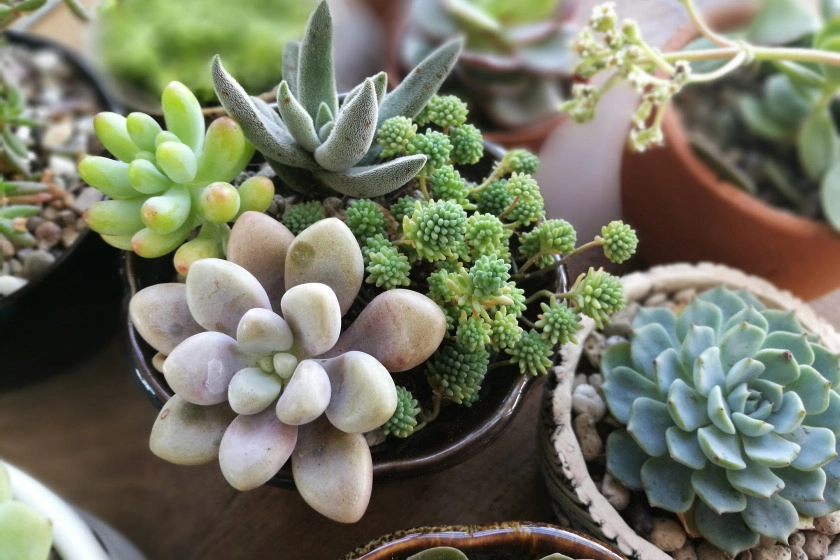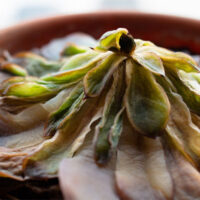Succulents are a darling of the gardening world, they are charming on a bookshelf, perfect on a windowsill, and are often considered houseplants. But succulents can also add many new elements to an outdoor garden. You can grow succulents outdoors in almost all climates. But how to care for outdoor succulents?
Table of Contents
7 STEPS FOR HEALTHY SUCCULENTS

Here are our top picks for basic care tips:
1. Temperature
While succulents can usually handle more rainfall than they do in their native habitat, their roots may rot if the soil is wet. Few succulents grow outdoors, where temperatures are chronically below freezing (32 degrees Fahrenheit). Hardy varieties are mainly thin-leafed perennial stony crops (Sedum) and hens and chicks (Sempervivum), which also do not do well in temperatures above 80 degrees.
2. Water
Summer
Your best succulents are watered thoroughly, but sparingly. Succulents like to dry up between waterings and hate the constant wetting of their roots. This is the rule whether the plant is indoors or outdoors. Stay away from ineffective sprays that can breed unhealthy bacteria. Be sure to saturate the soil with deep water to keep your succulents drinking for a long time.
Winter
During the winter months of December and January, your succulents will go to sleep with little sign of growth. This is where overwatering can cause actual damage to plants, and where the most damage can occur. Before watering, check to make sure the soil has very little moisture. Once the days get longer, towards the middle or end of February, you’ll see your plants actively growing again, which is a hint that you’re starting to water more often.
3. Sun and Shade
In general, give succulents half a day of full sun; ideally get full sun in the morning, then keep in bright or dappled shade for the rest of the day. Remember that the intensity and duration of sunlight vary with latitude and altitude, season, and different directions and locations in the garden. Also, the same succulent that basks in the sun all day on the California coast could be scorched in 30 minutes in Arizona.
Those varieties that want more sun and won’t bloom without it are those native to the Southwest, such as cacti, yucca, and South African aloe.
Succulents do need plenty of light to balance growth (so they don’t stretch), any succulents grown in low light or in a greenhouse should be hardened (introduced gradually) with greater sun exposure.
Here are a few things to keep in mind:
- Sunburns appear as permanent beige or brown patches that, if widespread, can kill plants.
- Few sun-intolerant plants, such as clover and hawthorn, make great houseplants.
- Variegated (striped) succulents have less protective pigment and require less sunlight than their solid-colored counterparts.
4. Soil and Drainage
The best soil for growing succulents, either in the ground or in a container, is a rough, fast-draining mixture. You can buy the cactus mix in bags, but it’s cheaper to make your own.
Although soil types vary by region, even within your own garden, the basic formula for ground planting is:
1/3 garden soil
1/3 compost
one-third pumice
If you grow mostly desert succulents, reduce the amount of compost and add sharp (large-grained) sand, such as construction sand or decomposed granite. If your native soil is poorly drained (typically clay), avoid letting the roots take root in the water by planting on top of the clay in a raised bed or mound.
For containers, mix bagged potting soil half and half with a pumice stone. Increase the pumice content of cacti and spurge, and reduce the pumice content of thin-leafed succulents such as sedum.
5. Pest Control
Prevent pest infestations by giving succulents good air circulation. Aphids and thrips resemble flower buds; scales tend to colonize stems; mealybugs (which look like a small fuzz) burrow into leaf axils.
Spray pests with 70% alcohol diluted 50% with water. The scales can be scraped off, but if the scales persist, treat them with garden soap (not dish soap) and garden oil. Immediately isolate all infected plants to prevent the spread of pests, and clean the area thoroughly.
Mold problems can arise in humid climates; keep the meat as dry as possible (sounds easy, but of course, it isn’t).
If pests seem to be winning, take cuttings from unaffected growth and plant them in fresh soil. Discard diseased plants, soil, and all material, and clean jars before reuse.
6. Easy on the Fertilizer
We like to keep it simple. You can water succulents weekly during the growing months (June to August), give them regular houseplant fertilizer, or use specific varieties of cactus and succulent fertilizers. Do not use fertilizers during the sleepy months, from December to mid-February. Just clean tap water is enough to keep them hydrated and happy.
Conclusion
The Succulents are very cute, and it is not difficult to plant it outdoors. As long as you pay attention to the above six points, you can care for outdoor succulents easily.
Read More: How Big Do Succulents Get?

















